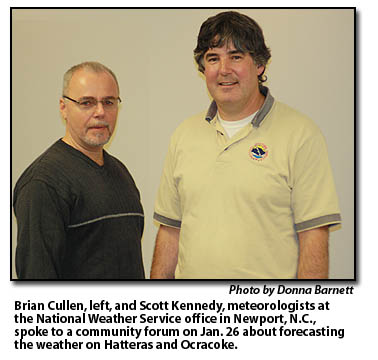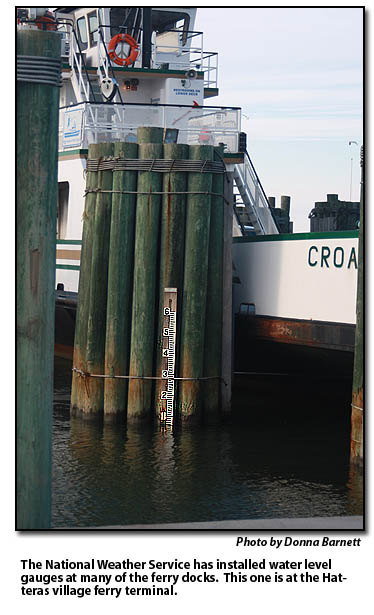Two meteorologists from The National Weather Service in Newport came to Hatteras on Tuesday, Jan. 26, with a message for us.
They want to hear from us to help them improve their coastal flooding forecasts, especially for soundside flooding.
And there may be an opportunity this weekend for us to help them out.
Meteorologists Brian Cullen and Scott Kennedy spoke to about two dozen islanders at a community forum on forecasting the weather on Hatteras and Ocracoke.  The trip to Hatteras was their idea after I spoke to them several times during the Nor?Ida storm and our two soundside flooding surprises on Friday, Nov. 13, and Friday, Nov. 27.
The trip to Hatteras was their idea after I spoke to them several times during the Nor?Ida storm and our two soundside flooding surprises on Friday, Nov. 13, and Friday, Nov. 27.
Cullen and Kennedy wanted to come to Hatteras to see the troublesome soundside flooding areas ? those that flooded the worst, the most frequently.
Their trip grew into both a tour of the lower half of Hatteras and a community discussion of the mission and work of the NWS in Newport and their efforts to improve the forecasting.
Their message to the islanders at the meeting was loud and clear ? they need eyes on the ground when they are forecasting coastal flooding.
?You may assume we know what?s going on, but that is not always the case,? Cullen said.
For instance, he noted the Nov. 13 soundside flooding.
Dare County had not mentioned soundside flooding in any of its media releases on the northeaster on Nov. 13, although it was already underway. The storm was much more dramatic as it pounded northern Rodanthe and the S-curves and wiped out a good section of Highway 12.
Though waves from the northeaster that lingered off the coast for about five days were devastating that area, there was little wind or overwash on lower Hatteras or Ocracoke.
But on Nov. 13, according to Ernie Foster, captain of the Albatross Fleet, boat captains at the Hatteras village docks were noticing that the wind was calm but the water level in the sound was rising. They figured soundside flooding was coming.
That is something that the meteorologists in Newport could not see, and there were no soundside coastal flood warnings issued that day.
Kennedy later said that the office found out about the serious flooding on Hatteras and Ocracoke from photos that islanders sent to The Island Free Press that were posted on Saturday, Nov. 14.
Anyway, Cullen and Kennedy don?t want that to happen again, so they encourage Hatteras and Ocracoke islanders to call the office in Newport to report flooding ? or even better to report unusually high water levels before the wind picks up.
Cullen said that he and Kennedy will emphasize to their colleagues that they need to listen to the input from islanders.
The current forecast calls for wind, rain, and more below-normal temperatures.
Beginning on Saturday, most of the wind will be northeast, probably to gale force. Late Saturday into Sunday, it will become more northerly. However, because of high water levels in the Pamlico Sound and a higher than normal lunar tide, there could be soundside flooding from this storm.
If that happens, let our friends at the National Weather Service office know about it.
It is, they noted, one of the few offices staffed 24 hours with a meteorologist on duty.
You can call them at 252-223-5737. Enter extension 7 to reach the meteorologist on duty and tell them Brian and Scott sent you!
Or you can go to the Web site at http://www.erh.noaa.gov/er/mhx/ , click on submit local storm reports in the menu on the left.
The Weather Service also maintains a network of volunteers to report rainfall amounts (http://www.crh.noaa.gov/lot/?n=cocorahs) and severe weather conditions (http://www.mhxskywarn.org/)
And the Weather Service is considering a water-level observation program to help forecasters improve their coastal flooding forecasts, especially on the soundside.
Cullen explained at the forum that the Newport office?s oceanside flooding forecasts are ?more stable,? as in they are correct more often.
The office has more problems with soundside flooding forecasts because the ?models? upon which they predict soundside flooding according to such factors as wind and storm surge are not as reliable.
Cullen said NWS is developing more reliable models with several state universities, but the forecasters are still handicapped by a lack of observation on the ground.
He said water level gauges have been installed at most North Carolina Ferry Division docks, including at the Hatteras Inlet ferry terminals at Hatteras and Ocracoke.
The next step, he said, will be to get volunteers to install gauges on their property.
Web cams at marinas and other places help, Cullen noted, but not much at night.
Before the community forum, Cullen and Kennedy toured lower Hatteras Island with Allen Burrus of Hatteras village, vice-chairman of the Dare County Board of Commissioners.
Burrus showed them sites that get soundside flooding frequently from Canadian Hole to the Hatteras village ferry docks.
Kennedy made notes on Google Earth maps and will use that to make a soundside flooding reference map for the NWS.


you propose that the government and the people work together? wow, what a cool concept! ok, enough sarcasm, the folks to live in a coastal generally have more practical knowledge that the theory based people who make the forecasts, it?s a great idea for them both to work together. hummm, now we need the park service and the island residents to work together?.nah, never happen.
The basic allure of Hatteras Island is that is not predictable. It’s on the edge and things change dramatically with a few degrees shift in wind and velocity.
I remember one night when the sound surged into Hatteras Village when there was no wind, yet the slash started creeping up into the parking lot of the motel. Fifteen minutes later the wind hit like a brick wall and you could only walk stooped over, forcing yourself into the wind.
I once made the mistake of not letting go of my front door knob, with a strong SE wind and ended up sitting on my sofa wondering what happened. Another time I opened up my car door the wrong way and almost got thrown out in the parking lot.
It cannot be controlled or realistically predicted. It exists, as it’s own entity and that is the magic of it. You are removed from your everyday existence and have to deal with what is. Don’t make the right decision and suffer the consequences.
It saddens me that certain groups would deny humans the experience of visiting Hatteras Island but if New York can ban salt in restaurants, we are certainly next on the list of things that are bad for you.
After all, you have to believe that they know best.
ive only lived on hatteras since 87 but have experienced many storms each withthere own wind and tidal personality,s. ive actually worked with the NWS taking water temps. and calling in with weather anomalies as they occur. ive always done it voluntarily, using my own gauges (often losing them and buying new ones)using my own gas,vehicle,time etc.never asked for money,would have been nice ,but didnt need it. got to know and befriend several of the people there especially iceman and Mark Willis who are generally concerned and interested in hatteras island.it did work for a long time and it can work.i enjoyed supplying know ledge and educational information to a governmental entity,also gaining the same from them.it was a symbiotic relationship, both parties gained and were better for it, not to mention the friendships that were developed . it became educational for everyone. its unfortunate that in this latest climateof untrust towards gov. agencies,enviro.groups(who want to put the environment ,birds ,wildlife, etc in environment jails so no can see or enjoy them and be educated)that there is apathy to accomplish anything together.i think it can happen in a person to person environment. look at all the volunteers through the years that worked at the lighthouse,mostly retired,but still had a stake in our island because its wild and beautiful and they reside here. have to go will finish thoughts later , it can work.